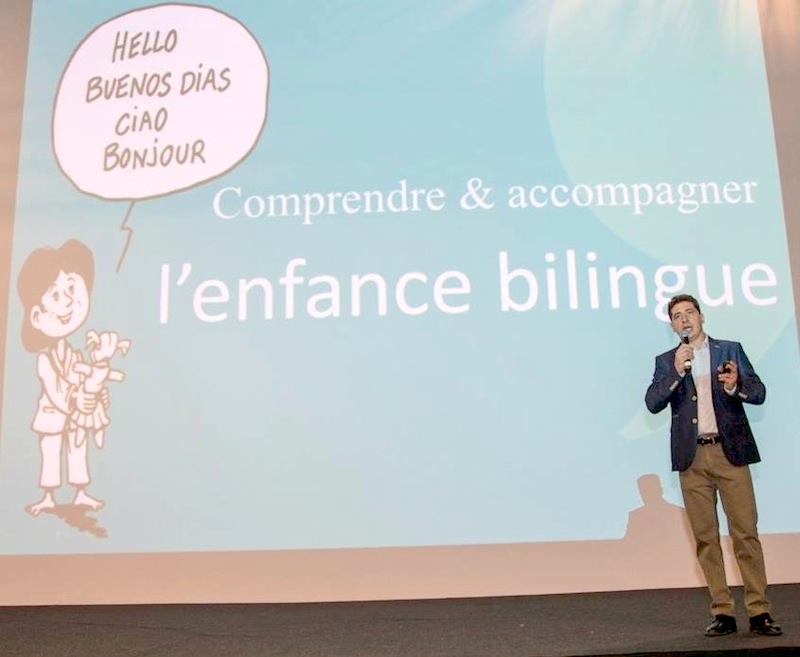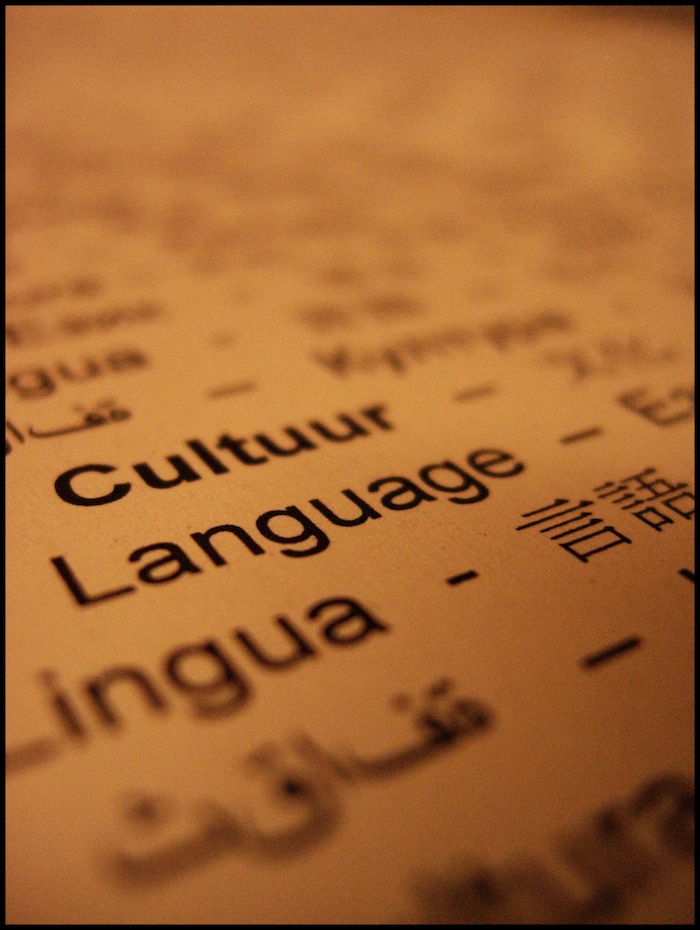
As well as being a medical expert for Mobilité Internationale (International Mobility Consultants), Doctor Franck Scola is a research author on the health and medical needs of expatriated families. It was in this role that he became interested in developmental variations of bilingual children and the learning and language difficulties that they might encounter. Amongst his own young bilingual patients he has documented the following: language delay, inability to recall words, selective mutism, stuttering, dysphasia, dyslexia, lack of vocabulary, speech impairments and deafness. Wishing to share the content of his recent university thesis entitled “The Conditions Which Favour Early Bilingual Education” based on over two hundred references, his own clinical studies, plus his day to day work as a general practitioner, he has just published a book called “Understanding and Supporting Bilingual Children – A guide for parents, teachers and carers”, (Edition Bookelis, Coll. Copernic, distributed by Hachette). We thank him wholeheartedly for such an interesting and comprehensive article.
Note about general language development
Milestones from the womb to the start of nursery school are as follows:
During the foetal period, the ear is already sensitive to sounds, noise from its mother’s body and to voices. Consequently, noises emanating from various sources are recognised (household noise, music, mother and father’s voice). The mother’s voice is more distinctive than the father’s as it is transmitted both internally and externally.
From birth, the infant recognises linguistic sounds and voices, showing a distinct preference for his mother’s rhythm and intonation.
At two months old, the infant enters the pre-linguistic period, a receptive phase that will prepare him for language acquisition. He can distinguish and memorise certain words and syllables and offer non-verbal responses to verbal commands. During this pre-language phase the infant spontaneously produces sounds: cooing at around two months, vocal play at three months and forming syllables by around eight months. The infant uses his mouth, lips, tongue and throat, to playfully produce sounds, obtaining a pleasant sensation that he will voluntarily repeat.
 From three to four months of age, infants can exchange vocal response with adults, tuning in, above all, to adults’ ‘baby talk’. Although at this stage parent-infant communication is essentially non-verbal, infants demonstrate receptiveness to the musical aspects of language and are enable to reproduce all the sounds of any given language before the end of their first year.
From three to four months of age, infants can exchange vocal response with adults, tuning in, above all, to adults’ ‘baby talk’. Although at this stage parent-infant communication is essentially non-verbal, infants demonstrate receptiveness to the musical aspects of language and are enable to reproduce all the sounds of any given language before the end of their first year.
The productive or locutionary stage occurs between eight and fourteen months of age. It is characterised by the child being able to understand certain words and say some in their correct context. These mainly consist of reduplicated sounds, i.e. a repeated syllable like “dada” for ‘daddy’ or “mama” for ‘mummy’. During this stage words are already culturally-orientated with ‘I’ being increasingly used by the end of period, denoting a differentiation between the infant and the person he is talking to (the interlocutor).
Around three years of age, the child’s sentence structure, although not yet consistently correct, begins to improve as he simultaneously becomes aware of himself as separate and distinct from those around him and is able to form relationships with others. His language, although not yet consistently correct, sentence structure begins to improve. His lexical stock (words that he has learnt) will now be around a thousand in number and he will start to conjugate verbs in the present, future and past tense of his first language. The child will constantly ask questions which allow him to check if he has been correctly understood and which also help to improve his verbal communication. He has now entered the basic language phase.
Starting nursery school means that he needs to use language that everyone can understand, not just his family members. At around three and a half years of age, syntax (arrangement of words creating well-formed sentences) develops, negation is clearly expressed, and the child learns to justify himself (e.g. using “because…”). It is through talking to a wider variety of people that his vocabulary becomes richer and he develops his ability to contextualise language.
Finally, the phase of acquired language takes place between four to six years of age, sentences are coherently constructed and vocabulary and syntax become more advanced. The child’s rate of speech slows down to marked rhythm displaying expressive intonation. Language contextualisation becomes increasingly more accurate.
But how does this work for a bilingual child?
Two situations emerge depending on when the child is exposed to the target languages:
– The first is when, from the start of his life, the child benefits from sufficient immersion in both languages to develop a simultaneous bilingualism. This is generally the case for children of mixed language couples where each parents speaks his own mother tongue in equal amounts to the child.
– The second is when the child has contact with other languages after his own mother tongue has been established. This is known as consecutive (or, alternatively, sequential) bilingualism. It is often the case for households in which the parents speak one language at home, but the child is exposed to the second at school. For the most part, this situation occurs for children of same-nationality migrants.
For pre-school-aged children, if they are simultaneously bilingual, acquiring one or indeed two first languages happens ‘naturally’, i.e. without any prompting from their entourage.
 The process of language acquisition in simultaneous bilingualism
The process of language acquisition in simultaneous bilingualism
Exposing a child to two languages from birth means that his entire pre-linguistic phase will provide a platform from which he can familiarise himself with the phonemes (single units of sound that have meaning in any language), intonation and rhythm of both languages. Even though phonemes from all languages are pronounceable during this phase, a child will start to specialise in his own language in the same way as he would if he were monolingual. Cries, cooing, babbling, and lallation (also known as canonical babbling meaning repetition of syllables ‘dada’ etc) contain a range of phonemes and intonations which become progressively restricted until they focus solely on the phoneme and intonation range of the child’s two languages.
In summary, the child stockpiles phonemes in both languages but does not differentiate between them. He does not distinguish between words or even phonemes. He will only distinguish between syllables.
– The child’s first words are said indiscriminately in either of the two languages and first sentences will be made up of words from both languages. This period is referred to as code mixing (alternatively known as code switching), proving that acquisition is based on a single lexicon (mental stock of words and terms) with words being added to it from both languages.
– During the second stage, the infant separates the two lexicons, but will continue to mix up grammatical constructs.
– Finally the two languages are separated lexically, syntactically and phonologically (meaning according to their sound).
When code mixing continues beyond three years of age, despite sustained daily learning of both languages, it is mostly a case of ‘typical bilingual talk’. This is not a display of linguistic ineptitude, but rather a communication strategy adhering to a precise set of rules
Chronological order of language development in simultaneously bilingual children
Simultaneously bilingual children acquire both their languages according to the same chronological pace, progress and speed of lexical acquisition as monolingual children.
– Before three years of age, the verbal communication of simultaneously bilingual children is formed on the basis of code mixing where words from both languages are juxtaposed in the effort to say something which makes sense. By naturally joining words or fragments of sentences that have meaning in one or both languages, the child demonstrates his lack of distinction between his two languages. He will go on to accumulate an even larger lexical stock in both languages amounting to that of a monolingual child of the same age.
– Around the age of three, the child becomes aware of the difference between the two languages.
Separation occurs progressively through the refining process of linguistic interference; a process once considered by those unversed in such matters to be a sign of linguistic incompetence. For example, the young child will say expressions using sounds from one language, but whose structure and syntax will belong to the other. Correction from adults helps to refine this separation as well as dialogue with school friends for whom the child will adapt his language so that he is better understood.
 This chronological process may be subject to several variables. If a child receives more exposure to one language than the other, it will become dominant. Likewise, he may develop a preference for one language as a consequence of the habitual situations in which he is exposed to it. This proves that children are able to contextualise language from a very early age.
This chronological process may be subject to several variables. If a child receives more exposure to one language than the other, it will become dominant. Likewise, he may develop a preference for one language as a consequence of the habitual situations in which he is exposed to it. This proves that children are able to contextualise language from a very early age.
The child’s perception of the language can be based on the ‘prestige’ that the adult, in particular, affords it. This perception may positively influence learning or else negatively affect it, triggering resistance, or worse still, reactionary behaviour such as selective mutism, aggression or isolation.
Observers using monolingual language acquisition as a benchmark are often bewildered by the sheer variation in learning rates amongst bilingual children.
If a child appears to be saying very little in one or both languages this may result in a hasty diagnosis of linguistic incompetence, language delay, or mutism (in extreme cases). Language acquisition may ‘appear’ delayed because the child is still learning grammatical structures in both languages. In fact, developmental stages for each language are the same as those of a monolingual child. Learning starts with the most simple, grammatical structures in both languages, hence, at any given age, the subsequent rate of language acquisition may vary.
Evolution of language development in consecutively bilingual children
The parents of a child who falls into this category are usually migrants who both have the same mother tongue. The child is monolingual until he mixes with others at the start of school and is taught in the official language of the host country. Such rapid acquisition of a second language between the ages of two and six years of age (from the start of school until learning to read) can be explained by the child’s vital need to be understood coupled with his lack of inhibition of making mistakes in front of others.
It is known that a second language is much more easily acquired once the mother tongue has been mastered.
A child’s mother tongue will not be the language of learning or be a measure of educational success unless the child goes to a bilingual school where teaching is in the host country’s language and in his mother tongue. Maintaining the mother tongue depends uniquely on the importance attributed to it, particularly if the family plans to return to their country of origin. The dominance that it has until the child starts school will fade out following the process of acculturation.
 Stéphane Di Méo (2010) notes that to become and remain bilingual, it is essential that exposure to the mother tongue be maintained throughout the child’s entire development, particularly from the start of school and foundations of formal learning. If these conditions are not met, the mother tongue language will son wane, starting with loss of expression, then passive bilingualism and, finally, complete extinction (known as attrition) resulting in a monolingual status.
Stéphane Di Méo (2010) notes that to become and remain bilingual, it is essential that exposure to the mother tongue be maintained throughout the child’s entire development, particularly from the start of school and foundations of formal learning. If these conditions are not met, the mother tongue language will son wane, starting with loss of expression, then passive bilingualism and, finally, complete extinction (known as attrition) resulting in a monolingual status.
False language delay in bilingual children
It has been demonstrated how the development of simultaneously bilingual children is more or less identical to that of monolinguistic children, except in regard to their first lexicon, the words stockpiled until the age of two. In fact, until the age of two, a bilingual child will know as many words, on average, as a monolingual child of the same age, but the words will be divided between the two languages.
The result is that he will appear to have a temporary lexical ‘delay’ in one language compared to his monolingual classmates, but will reach their level in one or both languages between the age of four and five with the same verbal maturity.
If an adult who is unfamiliar with the developmental aspects of bilingual language acquisition suspects that a bilingual child is showing signs of language delay, then it is advised that no specific measures be taken other than carefully observing the child’s progress and reviewing the situation after a few months, if deemed necessary.
Parents’ anxiety can exacerbate the situation. It is often generated or unintentionally perpetuated by their friends, family, teachers or care givers who are unprepared for dealing with bilingual learning. As key players in their child’s first language and approach to language in general, the psychological state of parents and the attitudes that extend from this will have an impact on how well their child will learn. Vast numbers of studies show that parents’ words of comfort towards their child are quintessential to successful language learning.
Despite awareness that a suspected delay is not immediately indicative of a problem, every simultaneously bilingual child must still be carefully monitored at the time of his psychomotor health review. Reviews should be meticulously carried out and involve a neurological examination of the sensory organs and speech apparatus.
Suspecting language delay in precocious consecutively bilingual children
Monolingual children, such as expatriates exposed to a second language as they start school or nursery in the host country, can face a real challenge which sometimes proves to be a temporarily traumatic experience.
 Following a period of mutism, when the child listens to the second language but will not speak it, he will then enter what is known as the ‘telegraphic language’ phase. Consequently, the first language may interfere with the second, possibly in a persistent manner until, over time, his second language becomes established.
Following a period of mutism, when the child listens to the second language but will not speak it, he will then enter what is known as the ‘telegraphic language’ phase. Consequently, the first language may interfere with the second, possibly in a persistent manner until, over time, his second language becomes established.
Since these two intermediary phases may spur fears of a language delay, it is comforting to parents to know that such language behaviours are, by and large, normal. The main point here is to be wary of premature and inaccurate interpretations that could lead to referral to a speech therapist untrained in this specialised area.
Let us be reminded that the first hurdle to communication is socialisation. Hence the motivating factor in learning the second language is therefore the vital need to communicate. It is therefore of no use, or moreover harmful, to put pressure on a child to learn a second language. All that is needed is to allow him the time to learn as he gets to grips with his new linguistic, cultural and social environment. A child must have access to immersion in the second language to be able to speak and write it competently. It is therefore of no use to hastily default to the help of a speech therapist. Intervention is only ever worthwhile if the child is showing little sign of improvement despite being exposed to ideal learning conditions.
Doctor Franck Scola
Provence, France
November 2015
This article been translated by Anna Callen of www.verdontraduction.com. We thank her wholeheartedly.
*for ease of translation, child gender has been referred to as male in this article.




